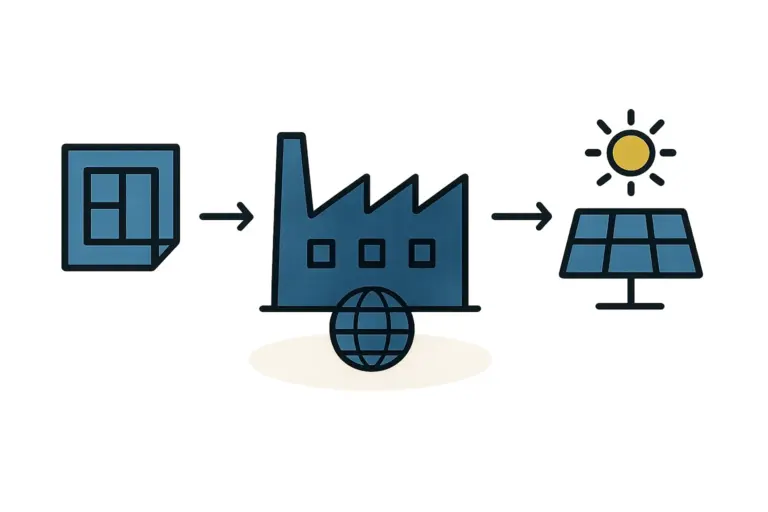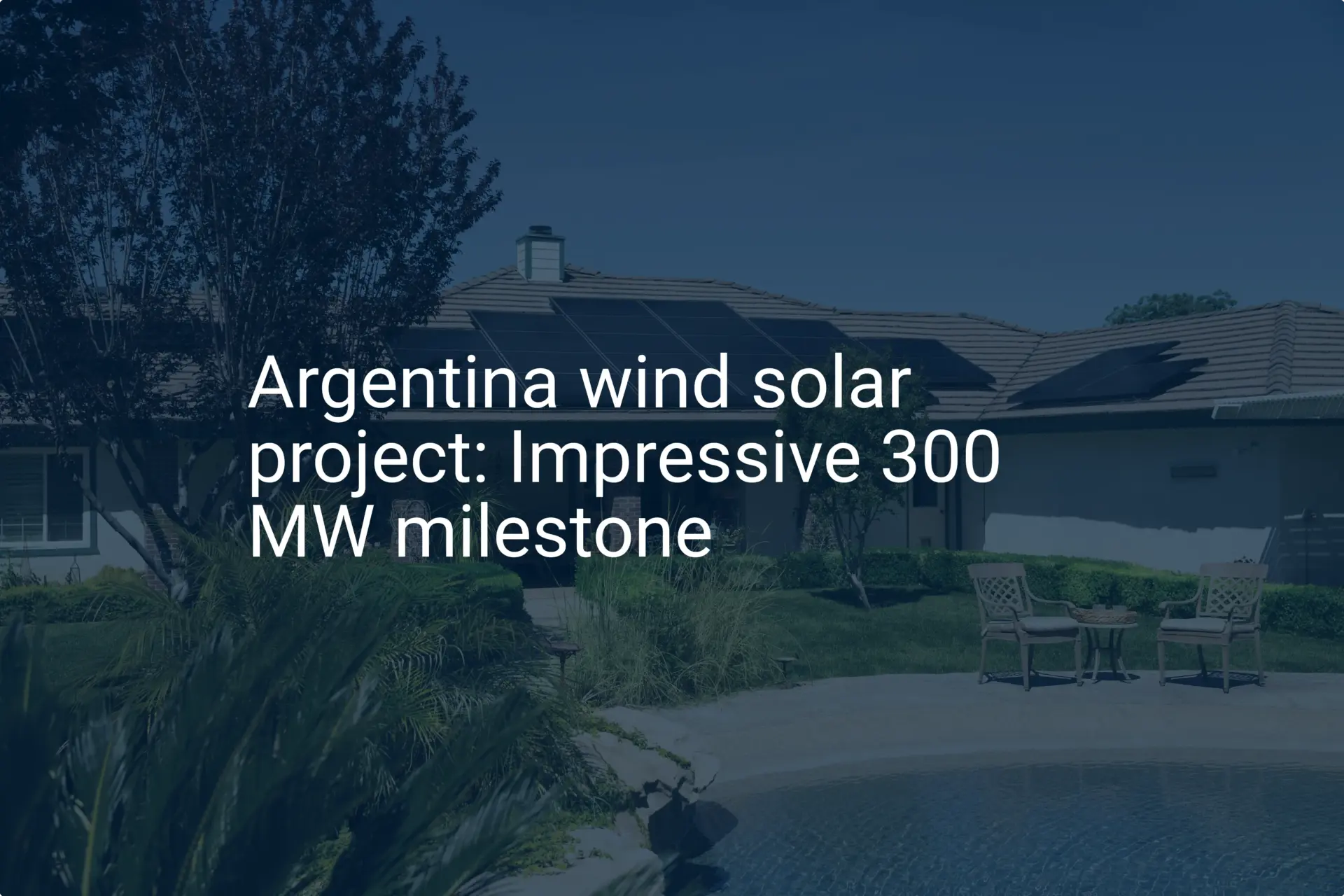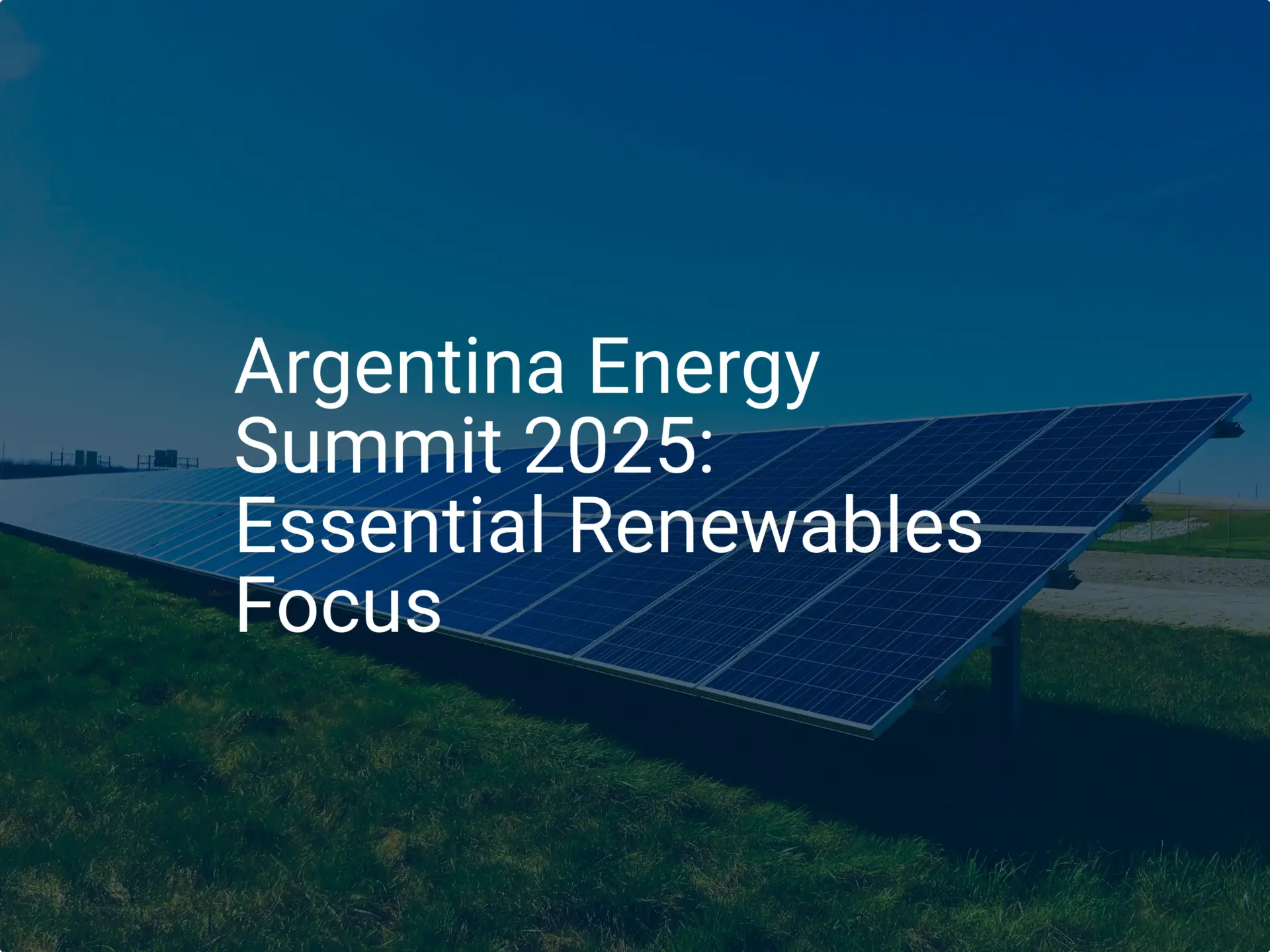Establishing Solar Panel Manufacturing in Argentina: A Deep Dive into Logistics, Infrastructure, and Site Suitability
Blessed with abundant solar radiation, particularly in its northwestern regions, Argentina stands at a pivotal moment. The country is increasingly looking to renewable energy to diversify its energy mix and foster sustainable development.
At the heart of this ambition lies the potential for a robust domestic solar panel manufacturing industry. However, success hinges on a thorough understanding of the operational landscape—from transportation networks and port facilities to energy infrastructure and the availability of suitable industrial zones. This analysis provides critical insights for any entity looking to establish efficient solar panel production in the country.
Table of Contents
Argentina’s Ambition in Solar Manufacturing: Setting the Scene
Argentina’s commitment to renewable energy is clear, underscored by national programs and a growing recognition of solar power’s economic and environmental benefits. The country has seen a steady increase in installed solar PV capacity, now at approximately 1,408 MW, with projections aiming for an impressive 4.5–5 GW by 2030.
 Solar Manufacturing in Argentina
Solar Manufacturing in Argentina” class=”wp-image-34146″ srcset=”https://www.pvknowhow.com/wp-content/uploads/2025/07/Infrastructure-Deep-Dive_-Logistics-and-Site-Suitability-for-Solar-Manufacturing-in-Argentina-2.webp 1536w, https://www.pvknowhow.com/wp-content/uploads/2025/07/Infrastructure-Deep-Dive_-Logistics-and-Site-Suitability-for-Solar-Manufacturing-in-Argentina-2-500×333.webp 500w, https://www.pvknowhow.com/wp-content/uploads/2025/07/Infrastructure-Deep- Dive_-Logistics-and-Site-Suitability-for-Solar-Manufacturing-in-Argentina-2-1024×683.webp 1024w, https://www.pvknowhow.com/wp-content/uploads/2025/07/Infrastructure-Deep-Dive_-Logistics-and-Site-Suitability-for-Solar-Manufacturing-in-Argentina-2-768×512.webp 768w, https://www.pvknowhow.com/wp-content/uploads/2025/07/Infrastructure-Deep-Dive_-Logistics-and-Site-Suitability-for-Solar-Manufacturing-in-Argentina-2-600×400.webp 600w” sizes=”auto, (max-width: 1536px) 100vw, 1536px” />
So, why the focus on local manufacturing? The strategic importance is multifaceted: it promises job creation, reduces reliance on imports, enhances energy security, and could position Argentina as a regional player in the burgeoning solar market.
A significant step in this direction is already underway with the development of Argentina’s first large-scale solar panel factory in San Juan province. This facility, which aims to produce 800,000 panels annually (around 450 MW) with plans to double capacity, signals a strong governmental push. It stands as a tangible example of the country’s manufacturing aspirations. However, realizing this potential on a broader scale requires a clear-eyed assessment of foundational elements like logistics and site suitability.
Got a solar vision? Empower it.
Our free e-course illuminates the path, while our specialized services provide the hands-on support you need. For those ready to lead the charge, our Premium Business Plan E-Course equips you with the strategic depth to revolutionize your solar business. Transform potential into powerful reality.
Navigating Argentina’s Logistics Landscape for Solar Manufacturing
Efficient logistics are the lifeblood of any manufacturing operation, particularly one that relies on both imported components and domestic distribution. For solar panel production, this involves the careful movement of raw materials, delicate machinery, and finished goods.

Transportation Networks: Moving Goods Efficiently
Argentina possesses a solid logistics services framework, but for industrial-scale operations, the nuances matter.
Roads:
Argentina’s road network is extensive, with major highways connecting key economic centers. These are crucial for transporting goods from ports to industrial zones and for distributing finished panels. However, quality and capacity can vary, especially in more remote regions. Businesses must assess road conditions specific to their supply chain and distribution plans, including the critical last-mile connectivity to potential factory sites.
Railways:
The rail network offers significant potential for heavy freight, connecting some industrial areas and ports. While historically significant, its current fitness for specialized industrial freight like solar components needs careful evaluation. Ongoing revitalization efforts and existing connections to key ports like those in Rosario or Bahía Blanca could present strategic advantages.
Logistics Providers:
A good range of local and international logistics providers operates in Argentina. Their experience handling specialized cargo, including sensitive manufacturing equipment and components, is a key consideration. The fact that companies like DHL offer specialized solar logistics solutions is a good sign, indicating a supportive ecosystem is already in place.
Challenges:
Realistically, the maintenance of existing infrastructure and the need for seamless intermodal connectivity (e.g., smoothly moving goods from port to rail to road) remain key challenges.
Port Facilities: Gateways for Materials and Equipment
Given that many raw materials, specialized components, and manufacturing machinery for solar panels are often imported, efficient port operations are paramount.
Major Ports:
Key ports include Buenos Aires, Rosario, and Bahía Blanca. These facilities handle the bulk of the country’s industrial inputs. Their capacity, equipment for handling oversized or delicate cargo, and storage facilities must be assessed in the context of a manufacturer’s specific needs.
Import Procedures:
Navigating customs and import procedures efficiently is vital. While the government has at times proposed helpful measures like eliminating import duties on renewable components, understanding the current regulatory framework and potential bureaucratic hurdles is essential.
Connectivity to Inland Industrial Zones:
The ease and cost of transporting goods from these ports to inland manufacturing sites are critical factors. The proximity of a port to an established or developing industrial zone can significantly impact logistical costs and timelines.
Potential Bottlenecks:
Port congestion, customs clearance times, and inland transportation links can all present challenges. Strategic planning and partnering with experienced logistics providers can help mitigate these risks.
Assessing Site Suitability: Infrastructure and Industrial Zones
Choosing the right location for a solar panel factory involves far more than just land availability. Critical infrastructure—particularly reliable energy and access to a skilled workforce—plays a decisive role.
Energy Infrastructure: Powering Production Lines
Solar panel manufacturing is an energy-intensive process. This makes a reliable and cost-effective electricity supply non-negotiable.
National Grid Overview:
Argentina’s national grid has a diverse generation mix, but outdated transmission networks can be a challenge. While the government plans for grid expansion, including 5,000 km of new lines, the reliance on private investment for these upgrades is a key factor to watch.
Reliability for Industrial Consumers:
The stability of the power supply is a major concern for any industrial user. Distribution losses of around 16% (a high figure compared to an international standard of 5–10%) and frequent power outages have affected millions. Businesses must carefully evaluate the reliability of the power supply in any potential region. The availability of high-voltage connections is also essential.
Cost of Industrial Electricity:
As of December 2023, the industrial electricity cost was approximately $0.024/kWh. Understanding tariff structures and potential future cost fluctuations is vital for accurate financial modeling.
Future Grid Development:
Ongoing and planned investments in grid modernization and expansion can significantly influence site selection, making areas with committed upgrades more attractive.

Identifying Suitable Industrial Zones
Argentina offers various industrial parks and zones, but not all are created equal for specialized manufacturing like solar panel production.
Industrial Park Landscape:
Established industrial parks, often located near major cities or logistics hubs, typically offer basic infrastructure.
Criteria for Optimal Solar Manufacturing Zones:
What should be on your checklist?
- Robust utility connections (electricity, water, gas)
- Excellent transport links
- Availability of a skilled labor pool
- Proximity to potential suppliers
- Supportive local government with streamlined permitting
Promising Regions:
San Juan province stands out, thanks to its proactive government policies, high solar irradiation, and the establishment of the country’s first major solar panel factory. This creates a potential ecosystem for related industries. Other regions with strong renewable energy potential may also present opportunities.
Land Availability and Costs:
For context, factory rent in areas like Buenos Aires for industrial spaces ranges from approximately $7.6–$7.8/sqm/month. Land purchase or lease costs in designated industrial zones will naturally vary by region.
Water Availability and Management:
Manufacturing processes require water, so a thorough assessment of its availability, quality, and the regulations governing its use and discharge is essential.
Workforce and Skills
Access to a capable workforce is crucial for efficient, high-quality production. The availability of engineers, technicians, and skilled assembly line workers must be assessed in any potential location. The presence of technical training institutions and government initiatives aimed at developing skills for the renewable energy sector can be a significant advantage.
Operational Intelligence: Policies, Incentives, and Challenges
Beyond physical infrastructure, the policy landscape, economic conditions, and inherent challenges all shape the operational environment for solar manufacturers.
Government Support for Solar Manufacturing
Argentina’s policies and programs to encourage renewable energy development can also benefit local manufacturing.
RenovAr Program: This program has been pivotal in promoting renewable energy projects through auctions and financial incentives, including tax benefits and soft loans.
Law 27.191: This law established a target for renewable energy to constitute 20% of national electricity consumption by the end of 2025.
FODIS (Fund for Distributed Generation): This fund supports distributed renewable energy systems, which can indirectly boost demand for locally manufactured panels.
Provincial-Level Incentives: Some provinces, like San Juan, go a step further by offering additional incentives to attract investment in their local solar sector.
Economic and Regulatory Climate
The broader economic and regulatory environment introduces both opportunities and significant considerations. High inflation and currency fluctuations can affect operational costs, investment planning, and profitability. Strategies to manage this economic volatility are essential. Understanding the ease of doing business—including the time and complexity involved in obtaining necessary permits—is also crucial.
Key Challenges for Solar Manufacturers in Argentina
A realistic assessment must also acknowledge the key hurdles:
Addressing Infrastructure Deficits: Limitations in the electricity grid and transportation networks require careful navigation and planning.
Managing Supply Chain Risks: A reliance on imported components exposes manufacturers to global supply chain vulnerabilities and currency risks.
Navigating Economic Volatility: The macroeconomic climate demands robust financial planning and sophisticated risk mitigation strategies.
Competition: New entrants will face competition from established global manufacturers who benefit from enormous economies of scale.
Fossil Fuel Subsidies: Historically, subsidies for fossil fuels have sometimes made it harder for renewables to compete on a purely cost basis, though this landscape is always evolving.
Strategic Considerations for Site Selection
When evaluating potential sites for solar panel manufacturing in Argentina, a comprehensive checklist should guide your decision-making:
Logistical Efficiency: How close and connected are you to ports, major highways, and rail lines? What are the cost and reliability of freight?
Energy Reliability and Cost: How stable is the grid in your chosen region? Are high-capacity connections available and are tariffs competitive?
Industrial Zone Suitability: What is the quality of infrastructure within the zone? Is there potential for future expansion?
Workforce Availability: Do you have access to skilled and trainable labor? Is there local training infrastructure to support you?
Cost Factors: What are the land costs, utility rates, labor costs, and local taxes?
Government Support: Are there national and provincial incentives, tax breaks, and grants applicable to your project?
Regulatory Environment: How clear and predictable are the permitting processes and business regulations?
Supply Chain Access: How close are you to potential local suppliers of raw materials or services?
Economic Stability Factors: What is your assessment of local economic conditions and what are your strategies to mitigate risks?
Long-Term Growth Potential: Does the site align with regional development plans and provide the market access you need for the future?
Conclusion: Is Argentina Ripe for Solar Manufacturing Investment?
Argentina presents a compelling, albeit complex, case for solar panel manufacturing investment. The nation’s abundant solar resources, growing domestic demand, and initial steps toward local production are all significant strengths. Government support programs further signal a genuine commitment to the sector.
However, prospective investors must meticulously evaluate the existing infrastructure. While transportation networks and port facilities are generally functional, regional capacities and bottlenecks demand due diligence. Energy grid reliability remains a critical factor, making it paramount to identify industrial zones with robust utilities, good connectivity, and access to a skilled workforce.
Navigating economic volatility and addressing a reliance on imported components are key challenges that demand sharp strategic planning. Yet, for those equipped with thorough research and robust risk mitigation strategies, Argentina offers a promising frontier for establishing solar panel production.
Turning this ambition into a thriving local industry will require careful navigation of these economic and logistical realities. With expert guidance and strategic site selection, companies can contribute to Argentina’s clean energy transition while building successful enterprises for years to come.
Frequently Asked Questions (FAQs)
What are the primary logistical challenges for setting up solar manufacturing in Argentina?
The key challenges involve ensuring reliable and cost-effective transport of materials and machinery from ports to inland factory sites. It also involves accounting for variations in road network quality, navigating customs procedures efficiently, and ensuring good last-mile connectivity to industrial zones.
How reliable is Argentina’s energy grid for industrial-scale solar panel manufacturing?
Energy reliability is a significant consideration. While Argentina is expanding its grid, issues like aging components, high distribution losses (around 16%), and potential power outages need to be assessed for any proposed site. An energy-intensive operation requires stable, high-capacity connections.
Are there specific industrial zones in Argentina particularly suited for solar manufacturing?
San Juan province has emerged as a focal point due to its high solar irradiation, proactive government support, and the establishment of a major solar panel factory. Ideal zones will offer robust utility infrastructure, good transport links, land availability, and access to a skilled workforce.
What kind of government incentives are available for solar manufacturers in Argentina?
Argentina has offered incentives through programs like RenovAr, Law 27.191, and the FODIS fund. Provincial governments, such as San Juan’s, may also offer specific local incentives. It’s crucial to check the current status and applicability of these programs.
What are the main economic factors to consider when planning a solar manufacturing plant in Argentina?
The key economic factors involve managing the impacts of high inflation and currency fluctuations on costs and investment returns. Understanding the local tax regime, labor costs, and the overall ease of doing business are also critical. Economic instability has been a historical challenge, so robust planning is essential.
How does Argentina’s port infrastructure support the import of manufacturing equipment?
Major ports like Buenos Aires, Rosario, and Bahía Blanca are well-equipped to handle industrial imports. Manufacturers should assess specific port capacities for specialized cargo, storage facilities, the efficiency of customs clearance, and connectivity from these ports to their chosen inland locations.
Disclaimer:
The information provided in this article is for general informational purposes only and does not constitute financial or investment advice. Market conditions, regulations, and specific data points can change. Independent research and consultation with local experts are recommended before making any business decisions.






